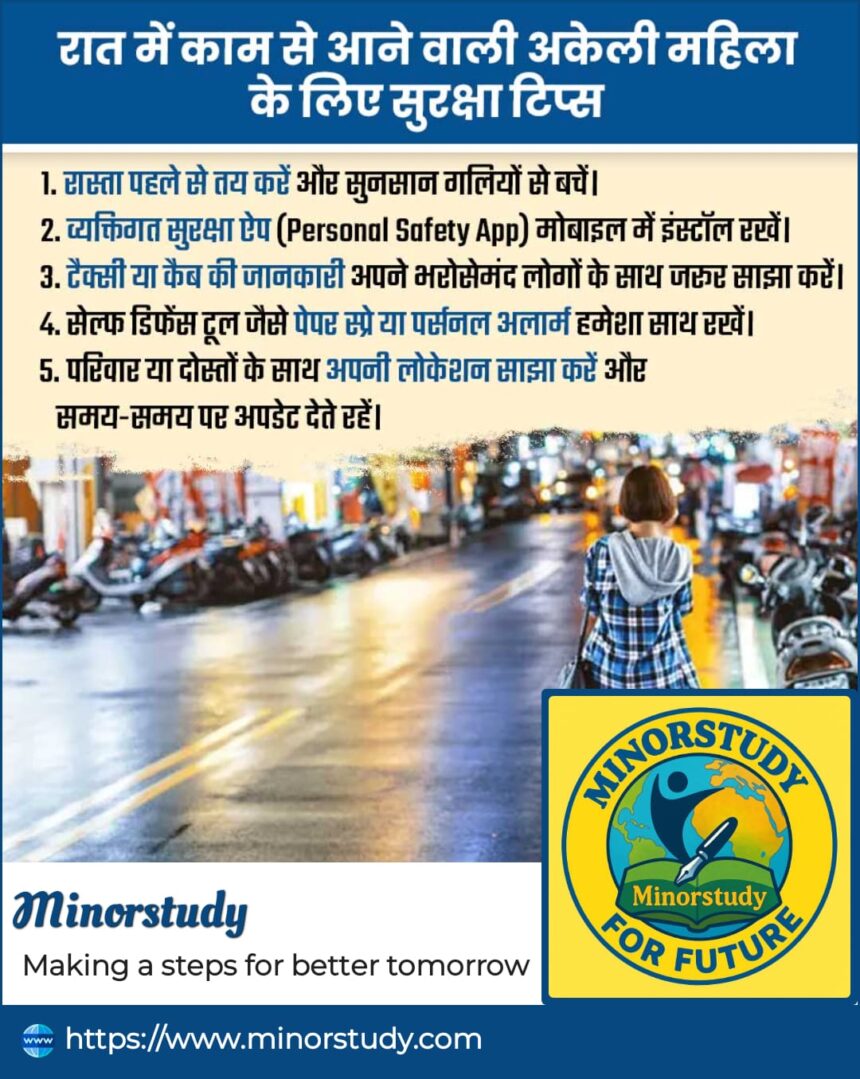🔐 Introduction
In today’s evolving world, single women are navigating professional and personal spheres with grace and independence. However, returning home late from work often poses significant safety concerns, especially in urban and semi-urban areas. This issue touches not only individual lives but also reflects broader societal dynamics, gender equity, and public safety infrastructure.
- 🔐 Introduction
- 🕰️ History: A Glimpse into Women’s Night Safety Concerns
- 📊 Facts and Realities to Know
- ⏳ Timeline: Evolution of Women’s Safety in India
- 🛡️ 9 Smart Night Safety Tips for Single Working Women
- 1. Always Inform Someone
- 2. Avoid Isolated Routes
- 3. Use Verified Transport
- 4. Carry a Power Bank & Torch
- 5. Use Safety Apps
- 6. Wear Comfortable Clothing & Footwear
- 7. Keep Pepper Spray or Key Defenses Handy
- 8. Avoid Distractions
- 9. Trust Your Instincts
- 🙋♀️ FAQs
- 🌍 Significance in Society
- 🫂 Observance & Initiatives
- 🎯 Key Takeaways
- 🎉 Wishing You Strength and Safety
- 🧭 Conclusion: Why Night Safety Still Matters
This comprehensive guide covers everything—from historical context, real facts, practical tips, FAQs, and daily life applications, to why this topic is deeply important for a safer society.
🕰️ History: A Glimpse into Women’s Night Safety Concerns
The issue of women’s safety at night isn’t new. Since the late 19th century, with women stepping into public workspaces during the industrial revolution, concerns over post-sunset commutes started surfacing. However, the conversation became more focused in the 1970s, during the second wave of feminism and urban planning movements, which highlighted how city infrastructure ignored women’s safety.
In India, incidents like the Nirbhaya Case (2012) brought women’s safety sharply into the public discourse, prompting legal reforms, fast-track courts, and a wave of tech-based safety tools.
📊 Facts and Realities to Know
According to WHO, 1 in 3 women globally experience violence in public or private spaces.
In India, 90% of working women report feeling unsafe returning home alone after dark.
Street lighting, reliable transport, and active community patrols significantly reduce fear perception among women.
Apps like Raksha, Himmat (Delhi Police), and MySafetipin have been introduced to support night-time safety.
Despite rising awareness, most reported assaults happen within 5 km of a woman’s residence—a shocking and important detail.
⏳ Timeline: Evolution of Women’s Safety in India
| Year | Event |
|---|---|
| 1970s | Urban feminist planning movement begins globally. |
| 1997 | Supreme Court issues Vishaka Guidelines on workplace harassment. |
| 2012 | Nirbhaya Case leads to widespread protests and new laws (POSH Act 2013). |
| 2014 | Launch of safety apps and government helplines in metro cities. |
| 2018 | “Safe City Project” started in 8 major Indian cities. |
| 2023 | Introduction of Nirbhaya Fund projects in tier-2 cities. |
🛡️ 9 Smart Night Safety Tips for Single Working Women
1. Always Inform Someone
Keep a close friend, family member, or flatmate informed about your commute, especially if it’s late.
2. Avoid Isolated Routes
Choose main roads with lighting and people—even if it adds a few extra minutes to your journey.
3. Use Verified Transport
Always opt for trusted cab aggregators like Uber, Ola, and check the license plate before boarding. Use the share-location feature.
4. Carry a Power Bank & Torch
Your phone must remain on and connected. A mini torch can be vital during power outages or remote locations.
5. Use Safety Apps
Install and actively use apps like:
Himmat (Delhi Police)
Safetipin
Raksha
These apps often feature emergency buttons and location tracking.
6. Wear Comfortable Clothing & Footwear
Heels and tight clothes can restrict movement. Comfortable wear allows for quicker reflexes if needed.
7. Keep Pepper Spray or Key Defenses Handy
Legally available pepper sprays, safety whistles, or even a key between your fingers can serve as quick deterrents.
8. Avoid Distractions
Refrain from wearing both earbuds at once or getting deeply immersed in your phone.
9. Trust Your Instincts
If something feels wrong, it probably is. Turn around, seek public help, or contact the police immediately.
🙋♀️ FAQs
Q: Is it safe to use public transport at night?
A: While major metro systems and buses are generally safe in big cities, always prefer crowded options. Avoid empty compartments or isolated stops.
Q: Can I legally carry pepper spray in India?
A: Yes, pepper spray is legal and widely available online or in pharmacies. It’s considered a non-lethal self-defense tool.
Q: What’s the emergency number in India?
A: Dial 112 — India’s all-in-one emergency helpline for police, ambulance, and fire.
Q: Are women-only cab services available?
A: Yes, services like SheTaxi, Hey Deedee, and Pink Cabs exist in certain metros.
Q: What should I do if I suspect someone is following me?
A: Immediately walk into a shop, petrol pump, or well-lit area with people. Call a friend or local police.
🌍 Significance in Society
Night safety for women isn’t a personal problem—it’s a public safety challenge and a gender rights issue. It reflects:
Urban infrastructure priorities
Access to justice and accountability
Trust in governance
Gender equality in workforce participation
Safe women = Empowered women = Stronger economy and society.
🫂 Observance & Initiatives
Every year, multiple observances remind us of this issue:
International Day for the Elimination of Violence against Women (Nov 25)
Nirbhaya Diwas (Dec 16) – In remembrance of the 2012 incident.
Women’s Safety Awareness Week – Organized by colleges, police departments, and NGOs.
These days often include self-defense workshops, legal rights sessions, and city-wide safety audits.
🎯 Key Takeaways
Awareness + Preparation = Empowerment.
Technology can be your best ally.
Trusting your intuition is never a mistake.
Night safety is not just your responsibility—it’s everyone’s.
🎉 Wishing You Strength and Safety
“To every woman returning home late after chasing her dreams: may you walk with courage, confidence, and calm. You are not alone.”
We wish strength, protection, and empowerment to all single working women. Keep shining—and let your safety be supported by smart choices and a strong community.
🧭 Conclusion: Why Night Safety Still Matters
Ensuring safety for women at night is not just about crime prevention—it’s about enabling freedom, opportunity, and peace of mind. When a woman feels safe, she dreams bigger, works longer, and contributes more fully to society.
As individuals, communities, and authorities, we must keep working toward a world where no woman has to look over her shoulder just to get home.
Together, let’s make that world a reality.








